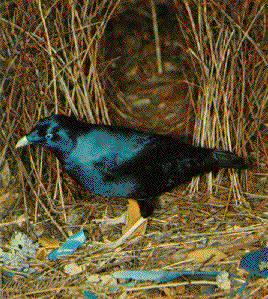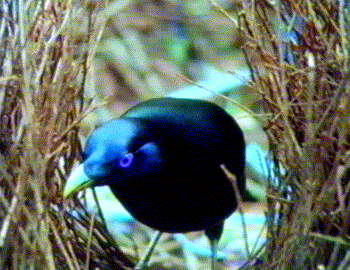

David,
Thanks for taking time to give me suggestions about building
my army of "fembots".
(Do you remember the fembots from
that Bionic Woman episode? It was a classic, let me assure you.)
Anyway, here's the rough description of my goals for the project.
Please feel free to contact me
if you have any questions.
Thanks for helping,
Gail


The Australian satin bowerbird has a unique and elaborate courtship ritual. Female bowerbirds stand inside stick structures called bowers, which are built by males, and watch males perform a courtship display. The male display involves many complicated and elaborate dance maneuvers and vocalizations and can last upwards of 20 minutes. During the courtship, the female appears to be giving signals to the male about her degree of interest. As she becomes more receptive to the male, she crouches forward (exposing her cloaca) and fluffs her wings slightly to the sides. I would like to determine if the male is reading and responding to the signals given by the female, and if so, how he is responding. I would also like to know if the males have strategies during courtship, which might change depending on the response he's getting from the female.
To determine how males are responding to females during courtship, I would like to create mechanical female bowerbirds which mimic the movements of real females during the process. Preliminary experiments with non-mechanical stuffed females have shown that males are willing to court and attempt copulation with just about anything, and are unlikely to reject the mechanical females.
Bowerbirds are approximately the size of a robin, with much thicker and stronger legs. A museum in Australia has agreed to donate museum mounted females, which are sturdy and stuffed with sawdust. These mounts can be opened and the sawdust removed to make room for interior components. The real legs can be removed and replaced with whatever mechanized legs are necessary.
Since I am interested in male response to female movements, I will need control over the position of the female through the courtship. Ideally, level of crouch would be divided into four degrees (C1, C2, C3 and C4) with the female able to move smoothly between degrees. All experiments will be controlled by a researcher sitting in a nearby blind. The researcher could have a remote control panel and change crouch position according to a predefined sequence; this sequence could either be pre-programmed or controlled directly by the researcher. The fluffing of the wings would also be controlled by the researcher.
Mechanical females will need to be able to stand in the bower during courtship. These bowers are avenues made from twigs placed on soft dirt. Females could be fitted with long spikes from their feet which could be pushed into the ground to support them. Alternatively, females could be mounted on a small platform (no greater than 3cm x 7cm) which could be placed into the bower and disguised with sticks.
There are many solutions to the problem of creating these mechanical females; solutions range from extremely complicated to relatively simple. My experience with field equipment has shown that simpler is far better. Equipment often takes a beating as it is transported and cannot be overly delicate or heavy.
In addition, even though I do not plan to use these in the rain, there is a chance that they will encounter unforeseen weather. For this reason, I am biased towards mechanical rather than electronic components. In addition, I would like to create 5 or 6 mechanical females, but I only have one mounted bowerbird here in America and will therefore need to finish assembling the birds in Australia. For this reason and, of course, cost of components and labor, simple is preferable.
I have videos of natural courtship that can be used as templates
for movement, and, as mentioned, I have a mounted female which
can be used to develop the mechanics. In addition, I plan to stuff
any deceased robins or starlings that I find, which can be used
for practice.